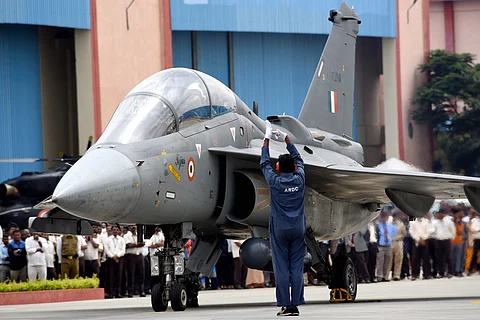

NEW DELHI: The government on Friday said it is exploring collaboration with a foreign defence major for co-production of engines for a medium combat aircraft.
India is working on an ambitious USD 5 billion project to develop the fifth-generation Advanced Medium Combat Aircraft (AMCA).
"Indigenous capability exists with DRDO and Indian industries for design, development and manufacturing of 80kN combat jet engine," Minister of State for Defence Ajay Bhatt said in Lok Sabha.
He was replying to a question.
"Collaboration with a foreign engine house is being explored for co-development and co-production of the higher class thrust engines for AMCA," he said.
"The cost including technology transfer for manufacturing the jet engine can be known after further progress," Bhatt added.
India's confidence for the development of the AMCA saw a significant jump after the development of the Light Combat Aircraft (LCA) Tejas.
Manufactured by state-run aerospace behemoth Hindustan Aeronautics Ltd (HAL), the Tejas aircraft is a potent platform for air combat and offensive air support missions while reconnaissance and anti-ship operations are its secondary roles.
In February last year, the defence ministry sealed a Rs 48,000 crore deal with HAL for procurement of 83 LCA Tejas fighter aircraft for the Indian Air Force (IAF).
To another question on whether the government proposes to revamp the Sahayaks system, Bhatt said "no".
Sahayaks in the Indian Army are soldiers and their duties include protecting the officers, maintaining their weapons and equipment and helping them in carrying out their responsibilities.
Sahayaks are also known as "buddies".
"In the Indian Army, a buddy has clearly defined military duties and forms an integral part of the organisation structure of a unit and has specific functions during war and peace," Bhatt said.
"During operations in the field areas, he and the officer/ JCO (junior commissioned officer) act as buddies in arms," he said.
"One covers the movement of the other buddy and protects him in operations where support has to be total, whether mental or physical or moral," Bhatt added.
The revision of pension for ex-servicemen under the 'One Rank One Pension' (OROP) is under process, the government said in Lok Sabha.
In responding to a question, Minister of State for Defence Ajay Bhatt said the revision is being carried out with effect from July 1, 2019.
The minister also cited an order by the Supreme Court on the matter.
The government issued notifications in 2015 announcing the implementation of the OROP scheme.
It had a provision for reviewing the pensions every five years.
"The Supreme Court vide its order dated March 16 directed that in terms of the communication dated November 7, 2015, a re-fixation exercise shall be carried out from July 1, 2019, upon the expiry of five years," Bhatt said.
"Revision of pension under OROP with effect from July 1, 2019, is under process," he added.
The OROP implies that a uniform pension be paid to the armed forces personnel retiring in the same rank with the same length of service regardless of their date of retirement.
To a separate question, Bhatt said the government has taken measures to "de-stress and upgrade the capabilities" of the soldiers and officers serving in the Army, Navy and Air Force.
Elaborating on the measures, he said training of soldiers and officers is conducted as per a well-planned schedule.
Bhatt said the steps included annual planning of major training and administrative events to "provide stability and predictability in commitments of personnel".
"In order to de-stress the soldiers and officers their daily/ weekly routine & training schedule is well spaced out and is designed to improve their physical and mental capabilities," he said.
India's military spending for the year 2021 was ranked as the third highest in the world, the government said citing data collated by Stockholm-based defence think-tank SIPRI.
"This (defence) ministry does not maintain expenditure data of other countries," Minister of State for Defence Ajay Bhatt said, replying to a question in Lok Sabha.
"However, as per data available on Stockholm International Peace Research Institute's (SIPRI) website, India's military spending for the year 2021 is ranked as third highest in the world," he said.
Bhatt was asked whether India's military spending is ranked third highest globally.
According to the details provided by Bhatt, citing data from SIPRI, the US ranked first with the expenditure of USD 800,672.20 million, followed by China's USD 293,351.90 million while the figure for India was USD 76,598.00 million.
Asked whether more than 50 per cent of defence equipment has been imported from 2017 to 2021, he said "no".
"During 2017-21, the percentage of foreign procurement (both revenue and capital) made for the purchase of stores/ defence equipment has been in the range of 33.97 per cent to 41.60 per cent," he said.
To a separate question, Bhatt said coastal monitoring and surveillance is being carried out on a real-time basis by the Indian Coast Guard around the country's coastline through a "chain of static sensors (CSS) consisting of 46 radar stations."
He said the infrastructure has been put in place under the Coastal Surveillance Network (CSN).
"Coastal surveillance system through chain of coastal high definition surface warning radars is one of the means through which coastal security is being implemented," he said.
"The radars have been installed since 2011 and there is no known harmful effect on the environment," he added.